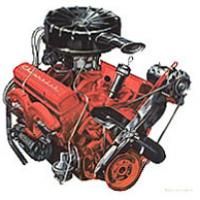The great small-block Chevy V-8 reached its second important development plateau in 1957. While the 265 was retained as the "base" engine this model year, the big news was the new 283-cid enlargement, achieved by punching out bore to 3.88 inches. In its mildest tune it produced 185 bhp at 4600 rpm; a four-barrel card brought this up to 220 bhp; two fours resulted in either 245 or 270; and Chevy's new "Ramjet" fuel injection system boosted output to no less than 250 or 283. The last was the ultimate, achieving the magic goal of one horsepower per cubic inch, and was offered with close-ratio three-speed manual transmission only.
The "fuelie" was carefully developed for good reliability. Mechanical valve lifters substituted for hydraulics when FI was specified. Longer-reach spark plugs with the metal deflection shields were used to protect wiring and plug caps from manifold heat. The top block was a thicker casting to prevent cylinder wall distortion though over-tight hold-down bolts. Fuel passages were tapered, increasing in cross-sectional area toward the inlet ports and in the "ram's horn" exhaust manifold to provide better scavenging and increased volumetric efficiency. There was new distributor, with the breaker points directly above the shaft bearing to help reduce fluctuations in the gap setting. And the front and intermediate main bearings were 0.063-inch thicker.
Advertisement
Though made by GM's Rochester carburetor division, the Ramjet fuel injection system was designed almost entirely by the Engineering Staff, simplified for production by Harry Barr and Zora Arkus-Duntov. It consisted of three main components: fuel meter, manifold assembly, and air meter, replacing intake manifold carburetor. The unit took in air first, then injected fuel directly into each intake port for mixing. The amount of fuel used was very precisely controlled, again for better volumetric effiency and mileage. Cold-weather starting and warm-up were improved, and the unit by itself boosted output by about 5 bhp compared to the twin four-barrel carbureted engine. Chevrolet claimed that FI eliminated manifold icing, and reduced the tendency to stall when cornering hard.
Advertisement
